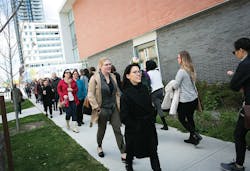Making an Impact
As interior designers, we are constantly presented with the opportunity to impact people’s lives. Every material we select, every space we fill, every view we highlight has an effect on the people who will live and work in each and every space. What we don’t often get to experience is the culmination of a cohesive view for an entire community, and the drastic and positive difference thoughtful design can make for a neighborhood in need.
This is an experience I was privileged to have in May when I traveled to Toronto, Ontario, to attend the second Impact Summit co-hosted by the American Society of Interior Designers (ASID) and Interior Designers of Canada (IDC). With a goal of exploring the impact of design on global issues, the Summit has attracted interior designers, educators, researchers, architects, city planners, and business leaders. This year’s topic, “Migration, Culture, and Diversity in the Built Environment,” brought together design thinkers who are interested in the role design can play in helping immigrants assimilate, refugees heal, and multicultural communities thrive.
The Impact Summits are quite different from the lunch-and-learns and trend presentations we designers frequent throughout the year. They are planned to prompt creative thinking and to dive deep into designers’ potential to make a true difference in the world, and to help solve some of the
distressing and sometimes overwhelming problems communities face.
Among the highlights of the Summit was a rousing tour of Toronto’s redeveloped Regent Park neighborhood. Formerly an underserved and crime-riddled area, Regent Park today is an enlightening example of the power of public-private partnerships and how the talent and creativity of design professionals with differing specialties can come together seamlessly for the betterment of an entire community.
We also heard from a powerful roster of speakers including the Honorable Ratna Omidvar, Senator for the province of Ontario, whose personal cultural background as an educator from India who, like her Iranian husband, came to Canada in 1981, afforded a distinct level of insight to her thoughts on statistical
diversity. Also lending personal and professional experience to his presentation was Richard van der Laken, founder and creative director of What Design Can Do, a conference devoted to humanitarian design. His belief that designers have the ability to tackle social and political problems that are often too messy and complicated for governments to solve was truly inspiring.
Also inspiring were my fellow attendees. From our intimate group discussions in which we developed achievable recommendations and action steps to bring back to our communities, to the individual connections made with fellow design professionals intent on making an impact through their work, I left the Summit energized to return to my own practice and exhilarated by the power of design.
The achievements of this Summit will continue as ASID is set to publish a whitepaper later this summer that will summarize the work accomplished there. And, the Impact Summit will return to tackle another global topic that can benefit from the vision of the design industry.
Charrisse Johnston, ASID, LEED AP BD+C, Associate AIA, is the Chair of the Board of Directors of ASID and a principal and the firm-wide interior design practice leader at Steinberg Architects. Learn more about ASID at ASID.org.
